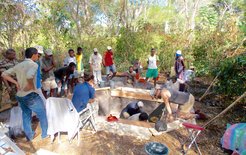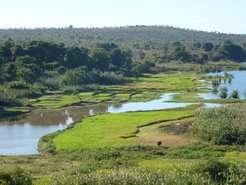Ancient Crops Provide a Window Into Madagascar’s Past

The team’s findings, published today in Proceedings of the National Academy of Sciences, offer the first clear ‘Austronesian’ signature in Madagascar’s archaeological record. Examining residues obtained from a process called flotation, which uses a system of sieves and water to remove ancient preserved plant remains from sediments, the researchers identified 2443 individual crop remains to species level under the microscope. The remains were obtained through archaeological excavations at 22 ancient settlement sites in Madagascar, the Comoros and coastal eastern Africa dating back to the 8th to 10th century CE.
“What was amazing to us was the stark contrast that emerged between the crops on the eastern African coast and the offshore islands versus those on Madagascar – but also the Comoros,” said Dr. Alison Crowther, of the University Queensland, lead author of the study, “and the more we looked, the starker the contrast became.” The crops identified on the eastern African coast and nearest islands were heavily dominated by African crops – species like sorghum, finger millet and baobab that had been present on the east African coast already for some centuries, brought by the expansion of farmers across the continent. In contrast, samples taken from sites on Madagascar and the Comoros contained few or no African crops, but were instead dominated by Asian species like Asian rice, mung bean and Asian cotton.

By examining where else in the Indian Ocean these crops were grown, and drawing also on historical and linguistic data, the team was able to make a strong case that the crops reached Madagascar from Island Southeast Asia. “There are a lot of things we still don’t understand about Madagascar’s past, it remains one of our big enigmas” said Dr. Nicole Boivin, Director of the new Department of Archaeology at the Max Planck Institute for the Science of Human History and senior author on the study, “but what is exciting is that we finally have a way of providing a window into the island’s highly mysterious Southeast Asian settlement, and distinguishing it from settlement by mainland Africans that we know also happened. Southeast Asians clearly brought crops from their homeland and grew them and subsisted on them when they reached Africa. This means that archaeologists can use those remains to finally start to provide real, material insights into the colonization process.”
One such insight is that it was not only Madagascar that was settled by Southeast Asians, but also the nearby archipelago of the Comoros, which sits between Madagascar and the northern Mozambique coast. “This took us by surprise,” noted Dr. Crowther “after all, people in the Comoros speak African languages, and they don’t look like they have Southeast Asian ancestry the way that populations on Madagascar do.” But linguistic evidence does provide some support for the team’s idea that the Comoros was part of the settlement process. “When we started looking more closely into research that has been carried out on Comorian languages,” pointed out Dr. Boivin “we were able to find numerous esteemed linguists who had argued for the exact thing we seemed to be seeing in the Comorian archaeological record – a settlement by people from Southeast Asia”.
Much work remains to be done. “We are keen to understand who these people were and what impact they had” said Dr. Crowther. “Amongst events that possibly coincide with the arrival of Austronesian speakers is the disappearance of Madagascar’s famous megafauna, which include giant species of lemur and sloths.” The team plans to return to Madagascar to continue their research. Dr. Boivin and Dr. Crowther are setting up new laboratories at the Max Planck Institute for the Science of Human History and University of Queensland that will collaborate closely in coming years.
“Jared Diamond has a great description of the bizarreness of Madagascar being colonized by people from thousands of kilometers across the Indian Ocean,” said Dr. Boivin. “He argued that it was akin to Columbus reaching the New World and finding it occupied by blond-haired, blue-eyed Scandinavians, speaking not Amerindian languages but something close to Swedish! We still have a lot to learn to understand how this distribution of people and languages came about, in particular the potential role of cross-Indian Ocean slave trading. Now we’ve given ourselves some new tools to work on this.”

